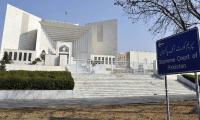In the first part of this series, I argued that Pakistan does not have a plausible option other than managing its existing water sources to develop itself economically, meet the needs of its growing population and address food insecurity.
One of the most alarming things is that 70 percent of our water is wasted due to inefficient irrigation and low agricultural productivity. The per capita water availability has declined to 900 cubic metres from 5,300 cubic metres in 1958. Moreover, Pakistan can only store 10 percent of its annual water flow – that can last for only 30 days against the global average of 120 days.
While the water debate is pertinent, given the sporadic droughts and looming food insecurity, the human angle of the impact the crisis will have on the environment, biodiversity and culture does not feature as an integral part of the solutions proposed in our mainstream policy debate.
The easy-going and complacent approach of investing in large-scale water reservoirs outlines discussions on tackling the impending water scarcity in Pakistan. At the heart of this discussion lies the fundamental fallacy of treating water shortage as a supply-side issue, instead of linking it to the failure of governance and accountability of the existing public institutions.
The core discussion among political pundits and some water experts has been about riding the bandwagon of building large-scale water reservoirs, like the Kalabagh and Bhasha dams, as a long-term solution to our water crisis. While it is imperative to conserve water, it will not be wise to propose building dams as the only solution in our context where wastage, and not the supply of water, is the major cause of crisis.
We need to understand the political economy of dams, keeping in view the global movement against construction of large dams in the presence of economically viable, indigenous, humane and environment-friendly options. We come across the argument that dams are inevitable not only because we need to conserve water for agriculture and industry but also because we need to generate cheaper electricity. This seems to be the cogent argument in favour of building dams, but it loses sight of the emerging perspectives that are more pragmatic, long-lasting and sustainable than building large costly dams.
Let’s bring forth these crucial but widely marginalised perspectives to broaden the horizon of our debate around the water crisis and its corollaries: power shortfalls, de-industrialisation and food insecurity. What makes these perspectives more important than our mundane polemics and conventional wisdom of building large dams is timeliness, cost-efficiency and environmental amelioration.
We have not been able to reach a national consensus on the Kalabagh Dam and we are likely to have similar outcomes in other mega projects in our bid to address the water crisis. Amidst political controversies and polemics, we have wasted seven decades without being able to articulate a unified national narrative towards an overarching national water development and conservation policy.
The proposals put forth by various commissions since the inception of Wapda in 1958 – like the proposal to build water reservoirs on 87 potential sites along the Indus Basin – could not be translated into action. The key impediments, as we all know, have been the political differences, economic constraints and lack of uninterrupted political governance.
Even if we are able to build a national consensus, we will still require billions of dollars to construct these big dams. And as a poor and economically impoverished country, Pakistan cannot afford to build large dams without foreign help, improving governance and democratic institutions and reducing corruption and rent-seeking behaviour. This requires a long-term integrated political and economic programme, whereas our water crisis is an urgent matter that needs to be tackled with or without political and economic reforms in place.
Most of us get carried away by the constant hammering of international water experts who advise building large dams in their reports. For them, constructing such dams are the most viable career-building options in a country that has diminishing water reserves.
The logic of building mega structures may work well for a country with adequate financial resources, strong accountability, an efficient compliance mechanism of environmental and social safeguards as well as absence of cheaper alternatives and extreme shortfalls of natural water flow.
The contemporary research on hydrology suggests that the existing natural spaces of water storage, such as aquifers, are much better and cost-effective than artificial spaces such as dams. If we recharge the depleting aquifers of Karachi and Lahore only we will be able to store more water than the total amount stored in the Tarbela, Mangla and Warsak dams – that too with negligible economic, social and environmental harm as compared to building a big dam like Kalabagh.
The Rechna, Thal and Bari doabs are viable options as aquifers and can store much more water than our total current storage capacity of 16 MAF. Aquifer recharge may be costly, but it is far less expensive than building even one dam the size of Tarbela.
One could argue that a dam is also needed to overcome our energy crisis, which means that we can produce almost 10,000 megawatts if we build two big dams in 15 years’ time. Let’s do a simple calculation here. Building a dam that has an estimated power generation capacity of 5GW may cost $10 billion. This power will be made available to the national grid in 15 years.
With our existing solar technology, it costs us around 85 cents to produce one watt. Given that we have $10 billion, we can produce 5GW within the first few months of the year to reach the target of 10GW in two years. One can deduce from this simple math that it is more efficient and cost-effective to generate 10GW from $10 billion in two years than produce 5GW in 15 years, that too at a huge social and environmental cost.
Pakistan neither has the money nor the technical expertise to build large dams and this is exactly why international experts see a promising career in such large-scale projects. Furthermore, the country will be technically and financially dependent on International Financial Institutions, and the money will be paid back with interest from the pockets of the poor countrymen.
Simply put, if a poor country like Pakistan has to construct a big dam it will have to take loans, with stringent payback conditions, from global financers. These international financial institutions actually invest in poor countries on behalf of the rich minority called donors. The donor countries usually provide tied aids to create business and employment opportunities to their own citizens at the cost of the poor people of the aid-recipient country.
By the time the country pays back the loan, say in 30 years, the mega structures will require major repairs and will hence, need more financial and technical support from the global financers.
To conclude, building dams is an expensive option that comes with an irreversible environmental and social cost and also has less potential of power generation than many other cost-effective solutions available today. It is of utmost importance that the incoming government forms a high-powered commission to explore alternatives to building dams.
The caretaker government had formed a committee of experts to address the water crisis. However, this committee seemed to be suggesting the construction of dams as the ultimate solution which is, of course, a non-starter in our context. We can hardly afford to sleep on proposals which did not work in the past. We must be able to set our priorities right to ensure sustainable solutions to our water crisis.
Concluded
The writer is a freelance
columnist based in Islamabad.
Email: ahnihal@yahoo.com
A health worker administers polio vaccine drops to a child during a door-to-door polio vaccination campaign in Lahore,...
Armed militants of the banned Tehreek-e-Taliban Pakistan pose for a photograph in Orakzai Agency. —...
An aeroplane of the national flag carrier of Pakistan is seen in this file photo. — AFPWhile Pakistan considers...
Representational image of a graph depicting various variables. — APP/FileInitiated by the centre and fiercely...
In this picture taken on April 16, 2023, people throng a market area during shopping in Lahore. — AFPOne of the...
Honour crimes also target men. In Sikandar Ali Lashari vs The State, SHC upheld conviction passed by ATC for honour...







